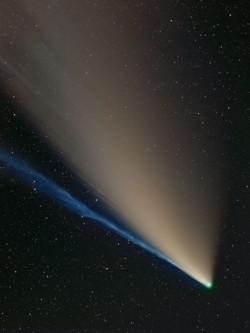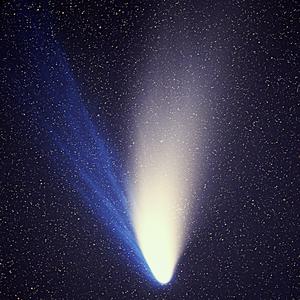Glossary term: 彗尾
Description: 當彗星靠近太陽時,太陽輻射會加熱彗星表面。表面的冰變成氣體("升華"),同時帶走岩石和塵埃物質。由此產生的混合物在彗核周圍形成一團雲,這就是彗發。一般來說,彗星會有兩條尾巴:噴射出的塵埃粒子形成彗尾,彗尾呈典型的彎曲狀。它由從表面釋放出來的塵埃粒子組成,這些塵埃粒子沿著彗星的軌道繞太陽運行。塵埃尾的長度可達數百萬公里或更長。它們反射太陽光,如果條件合適,肉眼能觀測到的彗星大部分都是由它們的白色漫射形狀組成的。
相當一部分氣體被太陽風--太陽發出的帶電粒子--吹走並電離。這些離子形成了彗星的離子尾,通常呈藍色。離子尾總是直指太陽。如果彗星本身正在遠離太陽,離子尾就會在彗星之前。
Related Terms:
See this term in other languages
Term and definition status: The original definition of this term in English have been approved by a research astronomer and a teacher The translation of this term and its definition is still awaiting approval
This is an automated transliteration of the simplified Chinese translation of this term
The OAE Multilingual Glossary is a project of the IAU Office of Astronomy for Education (OAE) in collaboration with the IAU Office of Astronomy Outreach (OAO). The terms and definitions were chosen, written and reviewed by a collective effort from the OAE, the OAE Centers and Nodes, the OAE National Astronomy Education Coordinators (NAECs) and other volunteers. You can find a full list of credits here. All glossary terms and their definitions are released under a Creative Commons CC BY-4.0 license and should be credited to "IAU OAE".
If you notice a factual or translation error in this glossary term or definition then please get in touch.
Related Media
彗星 C/2020F3 (Neowise),有分開的塵埃尾和離子氣體尾,以及發出綠色光芒的彗發,作者 Dietmar Gutermuth,德國
Credit: Dietmar Gutermuth/IAU OAE
License: CC-BY-4.0 Creative Commons 姓名標示 4.0 國際 (CC BY 4.0) icons
你好,彗星,我們跳舞好嗎?作者羅伯特·巴爾薩,斯洛伐克
Credit: 羅伯特·巴爾薩/國際天文學聯合會教育辦公室
License: CC-BY-4.0 Creative Commons 姓名標示 4.0 國際 (CC BY 4.0) icons
海爾-波普彗星
Credit: E.Kolmhofer, H. Raab; Johannes Kepler Observatory, Linz, Austria credit link
License: CC-BY-SA-3.0 Creative Commons Attribution-ShareAlike 3.0 Unported icons











